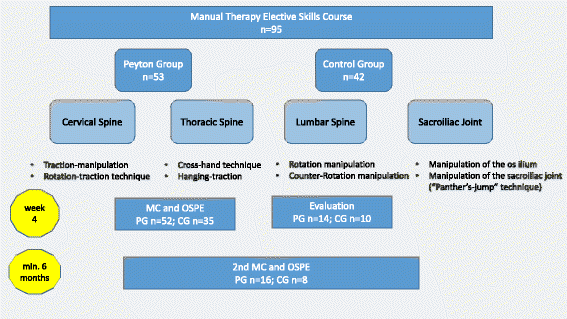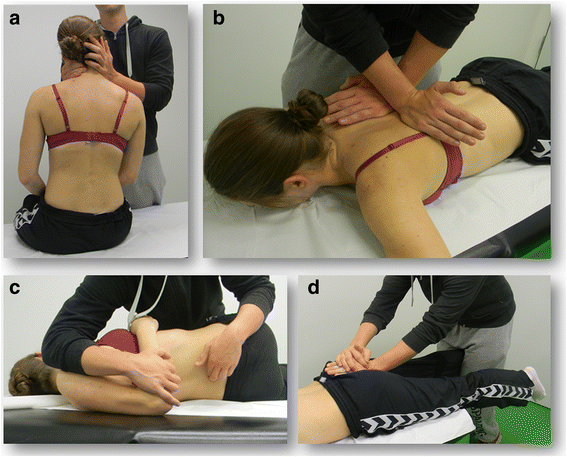Peyton's four-step approach for teaching complex spinal manipulation techniques - a prospective randomized trial
- PMID: 27809905
- PMCID: PMC5094089
- DOI: 10.1186/s12909-016-0804-0
Peyton's four-step approach for teaching complex spinal manipulation techniques - a prospective randomized trial
Abstract
Background: The objectives of this prospective randomized trial were to assess the impact of Peyton's four-step approach on the acquisition of complex psychomotor skills and to examine the influence of gender on learning outcomes.
Methods: We randomly assigned 95 third to fifth year medical students to an intervention group which received instructions according to Peyton (PG) or a control group, which received conventional teaching (CG). Both groups attended four sessions on the principles of manual therapy and specific manipulative and diagnostic techniques for the spine. We assessed differences in theoretical knowledge (multiple choice (MC) exam) and practical skills (Objective Structured Practical Examination (OSPE)) with respect to type of intervention and gender. Participants took a second OSPE 6 months after completion of the course.
Results: There were no differences between groups with respect to the MC exam. Students in the PG group scored significantly higher in the OSPE. Gender had no additional impact. Results of the second OSPE showed a significant decline in competency regardless of gender and type of intervention.
Conclusions: Peyton's approach is superior to standard instruction for teaching complex spinal manipulation skills regardless of gender. Skills retention was equally low for both techniques.
Keywords: Gender differences; Instructional method; Medical education; Peyton’s four-step approach; Spinal manipulation.
Figures
Similar articles
-
Comparing video-based versions of Halsted's 'see one, do one' and Peyton's '4-step approach' for teaching surgical skills: a randomized controlled trial.BMC Med Educ. 2020 Jun 17;20(1):194. doi: 10.1186/s12909-020-02105-5. BMC Med Educ. 2020. PMID: 32552805 Free PMC article. Clinical Trial.
-
Basic echocardiography for undergraduate students: a comparison of different peer-teaching approaches.Eur J Trauma Emerg Surg. 2018 Feb;44(1):143-152. doi: 10.1007/s00068-017-0819-1. Epub 2017 Jul 17. Eur J Trauma Emerg Surg. 2018. PMID: 28717985 Clinical Trial.
-
Undergraduate Curricular Training in Musculoskeletal Ultrasound by Student Teachers: The Impact of Peyton's Four-Step Approach.Z Orthop Unfall. 2019 Jun;157(3):270-278. doi: 10.1055/a-0715-2435. Epub 2018 Oct 12. Z Orthop Unfall. 2019. PMID: 30312980 Clinical Trial. English, German.
-
An appraisal of the literature on teaching physical examination skills.Educ Prim Care. 2012 Jul;23(4):246-54. doi: 10.1080/14739879.2012.11494117. Educ Prim Care. 2012. PMID: 22925956 Review.
-
Tips for teaching procedural skills.BMC Med Educ. 2020 Dec 3;20(Suppl 2):458. doi: 10.1186/s12909-020-02284-1. BMC Med Educ. 2020. PMID: 33272273 Free PMC article. Review.
Cited by
-
Frequently Used Conceptual Frameworks and Design Principles for Extended Reality in Health Professions Education.Med Sci Educ. 2022 Sep 9;32(6):1587-1595. doi: 10.1007/s40670-022-01620-y. eCollection 2022 Dec. Med Sci Educ. 2022. PMID: 36532382 Free PMC article.
-
Surgical suture course for dental students with the Peyton-4-step approach versus the PDCA cycle using video assisted self-monitoring.BMC Oral Health. 2020 Dec 30;20(1):365. doi: 10.1186/s12903-020-01309-x. BMC Oral Health. 2020. PMID: 33380320 Free PMC article.
-
Confronting the Challenges of Anatomy Education in a Competency-Based Medical Curriculum During Normal and Unprecedented Times (COVID-19 Pandemic): Pedagogical Framework Development and Implementation.JMIR Med Educ. 2020 Oct 7;6(2):e21701. doi: 10.2196/21701. JMIR Med Educ. 2020. PMID: 32873536 Free PMC article.
-
Exploring medical student perceptions of a video-modified Peyton's 4-step technique for teaching spinal and neurological examinations.Med Educ Online. 2025 Dec;30(1):2519391. doi: 10.1080/10872981.2025.2519391. Epub 2025 Jun 16. Med Educ Online. 2025. PMID: 40518978 Free PMC article.
-
Development of a basic evaluation model for manual therapy learning in rehabilitation students based on the Delphi method.BMC Med Educ. 2024 Sep 4;24(1):964. doi: 10.1186/s12909-024-05932-y. BMC Med Educ. 2024. PMID: 39232741 Free PMC article.
References
Publication types
MeSH terms
LinkOut - more resources
Full Text Sources
Other Literature Sources



